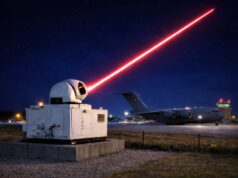Elbit Systems Hermes 45 Small Tactical Unmanned Aircraft System (STUAS) will be making its first appearance at the Company’s static display area in the upcoming Paris Airshow 2019.
The company say that Hermes 45 offers a combination of extended range and duration with point launch and recovery, to and from land and maritime platforms thus enhancing Intelligence, Surveillance, Target Acquisition and Reconnaissance (ISTAR) capabilities at the brigade and division levels and also for naval squadron units.
Hermes 45 has a range of 200km and an internal payload bay that supports multi-payload operation, including EO/IR, Marine-Radar, Electronic Warfare and communications.
The Hermes 45 is operated by a two-person crew, launched from a short onboard platform rail, and is recovered by an automated spot landing system.
Elad Aharonson, Executive Vice President and General Manager of Elbit Systems ISTAR Division, commented in a release:
“The Hermes 45 is important addition to our wide portfolio of UAS ranging from MALE to multi-rotor. The exceptional level of operational experience together with continuous innovation, enable us to enhance our customers capabilities in every domain of engagement.”













Can these be launched from the HMS Queen Elizabeth?
They aren’t massive so they could store quite a few.
Definitely could be: https://www.youtube.com/watch?v=Tlnqg3gqu0c
Pretty low 20kg payload capacity though. The landing/recovery is right at the end of the video. Couldn’t quite get bouncy castles out of my head and make myself take the last bit seriously.
I agree on the bouncy castle bit! You could obviously launch and recover from an OPV flight deck, or larger, but I wonder how that landing contraption would stand up to 20 or 30 knots of wind over the deck.
If every ship in a carrier task group had a couple of these that could make for a pretty powerful defensive advantage. They could be on 24 hour continuous circuits at a pretty wide range and make sneaking up on the group almost impossible.
Even if it’s just for search and rescue it’s got to be worth a purchase.
It could be a very cost effective way of rendering the Crowsnest programme redundant.
Why bother with these?
Just work towards getting Phasa 35 or the Zephyr operational. 75k ft altitude, 3 month to a year mission duration. Practically zero running costs.
No ridiculous bouncy castles…
Just had a quick look at those – I knew of Zephyr but not Phasa 35.
Phasa 35 looks very interesting but according to the Wikipedia entry Zephyr 8 is only quoted as having a 5kg payload (excluding batteries). That’s not a whole lot is it? Phasa 35 on the other hand is quoted (here – http://prismaticltd.co.uk/products/phasa-35/) as having a 15kg payload and as you say a 1 year mission duration. That does become interesting. I think we’ll still be stuck with bouncy castles though – kids love them. I suppose at least there’d be less danger of a Hermes 45 trying to land on one during local village fetes.
I don’t know why the UK never developed Mantis, we had it flying more than 10 years ago. Probably a mix of BAe wanting too much to get it into production and urgent requirements for Afghanistan. Missed opportunity in my opinion.
Interesting to see how the Defence Committee views our future air combat capability Expat. I’m sure some will find it very interesting. Hopefully, Taranis will have the power to take off and land on the QE carriers?
I wonder what will change when the next government takes office?
“13. This DPOC OR is a possible contender for a move in the direction of UCAV. Work is being carried out by BAE Systems with the Strategic Unmanned Air Vehicles (Experiment) Integrated Project Team (SUAV(E) IPT) responsible for auditing and overseeing the “Taranis” project. However, this 18,000 lb (Hawk sized) £143 million development aircraft is due to fly in 2013 and is some way off providing the RAF with certain future stealth DPOC. In the interim, the cost of each F35B Lightning II is now officially acknowledged by the NAO to be circa £90 million, which has necessitated the UK reducing its buy from 138 to 48. The cost of acquiring, arguably limited “stealth” capability, absorbing large chunks of the defence budget affecting, as Congressman Forbes says in a US context, many other programmes.”
https://publications.parliament.uk/pa/cm201314/cmselect/cmdfence/772/772vw14.htm
That figure of 48… Is that meaning the £90 million price tag has necessitated a reduction to 48 of the INITIAL order (with more to come totaling 138) or is this an unintended slip of the tongue that we actually intend to only acquire 48 air frames TOTAL over the life of the program!? But have not yet made that public knowledge?
That quote was from July 2013. This from December 2017 talks again of the 138 by the mid 2030’s.
Some interesting reading and worrying on many counts.
https://publications.parliament.uk/pa/cm201719/cmselect/cmdfence/326/32610.htm#_idTextAnchor045
I hope not!
“F-35 jets: Chinese-owned company making parts for top-secret UK-US fighters”
“Describing its involvement in the aircraft programme, the MoD publication said: “Gloucestershire-based Exception PCB manufacture the circuit boards that control many of the F-35’score capabilities.”
https://news.sky.com/story/f-35-jets-chinese-owned-company-making-parts-for-top-secret-uk-us-fighters-11741889
We used the 450 in Helmand, saved a few lives so it did.
Looks like a copy of the US Scan Eagle drone.
Might be slightly larger.
But the landing mechanism is inventive, but ludicrous. No way anyone is sticking that on a ship.
In contrast Scan Eagle/Blackjack/Integrator is a much smarter recovery system.
Not seeing anything interesting here at all to be honest.